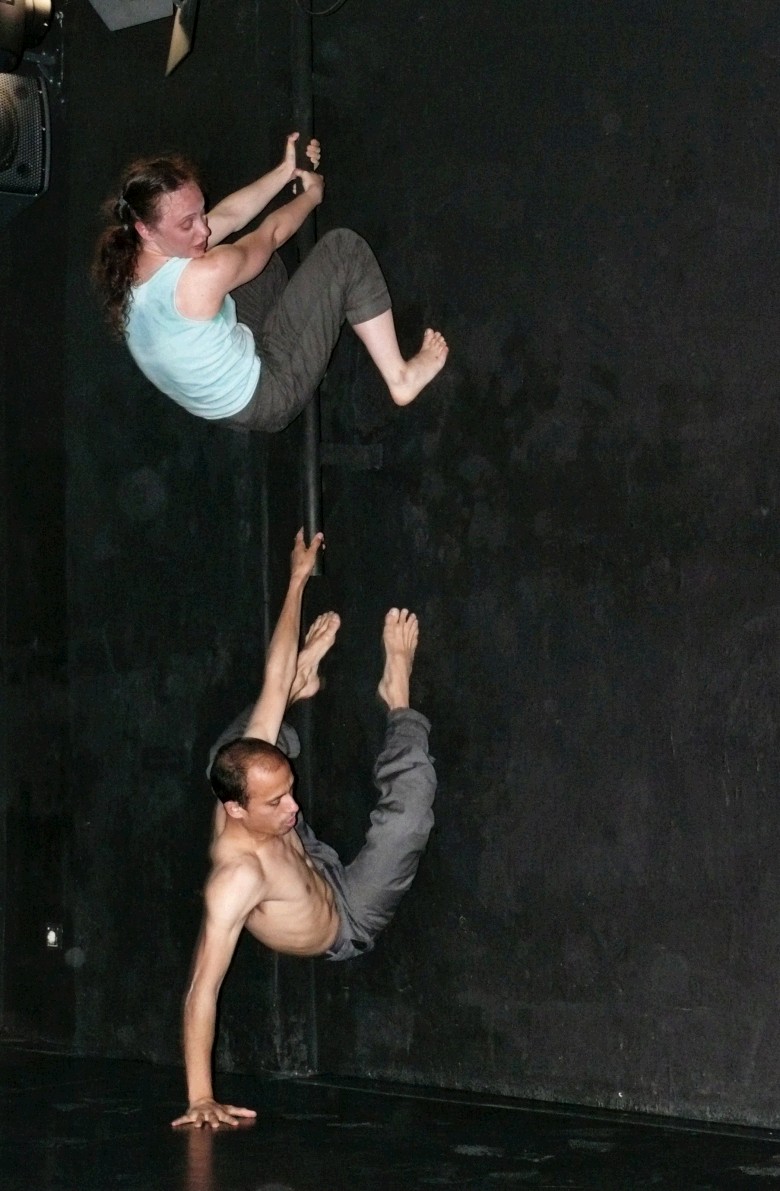
Cynthia Gonzales and Lazaro Godoy:
Jugo de Limon, Mementos vividos, Improvisation
Cynthia Gonzalez and Lazaro Godoy [dance]
Krishan Zeigner [percussion]
Projekttheater Dresden, 2 May 2009

When Lazaro Godoy talked about looking for a lemon to squeeze into sugar water in his solo Jugo de Limon, he was recalling his youth in Cuba, where he used to get a glass of sugar water at school every day. He craved for lemons for the flavor as they were not provided.
Personal note on sugar... While I was growing up in Czechoslovakia, my country imported masses of sugar from Cuba. I nibbled on the same sugar as Lazaro. Cuban adherence to sugar production after it became uneconomical was one of the key causes of the failure of the economy, as Fidel Castro once admitted.
When he was fifteen, Lazaro's family moved to Florida. This proved pivotal for his visit at Projekttheater, because there in the New World School of Arts he met with Cynthia Gonzalez. They studied and once even danced a duo together. Fifteens years later, Lazaro and Cynthia encountered again in Bern, Switzerland. Cynthia came here from Dresden and Lazaro finished a five-year stay with the Stijn Celis's ballet company and was in the process of moving to a new domicile in Israel. So Cynthia, who I never before saw dancing with a male dancer, asked Lazaro to accompany her to the Tanzwoche festival in Dresden at which she participated regularly since 2005.

More ghost-like than human figures in an orchard, projected on a curtain at the back of the stage with Lazaro in the foreground. Bending down and pointing their arms towards the ground in an enigmatic gesture, similar to each other like clones, the figures evoke the impression of extraterrestrials rather than dancers. The projection sets the stage for Lazaro's solo during which he pulls, twists and tugs his black shirt down and sideways. Eventually he pulls the shirt half-way over his head, becoming one of the creatures he observed before.

What you see above is not a trick: Lazaro's whole weight resides on his head. It hurts even to watch. The spectacular position lasted for half a second, just enough for a snapshot. Maybe a reminiscence of little Lazaro's practicing break-dance on the streets of Cuba?

Cynthia's Mementos Vividos are memories of her childhood in Bolivia. In contrast to Lazaro's reflections she is explicit and verbal. The text she recites while dancing is a masterpiece of prose on its own. In a plain and candid language (in German) she reflects on her childhood in Bolivia, the nature she loved, sounds of the jungle, the parrots, frogs and giant ants that once colonized their home. She talks about her family, the poverty they suffered, about her playing truant. She recalls her father killing tarantulas with a torch and the crackling sounds the creatures made while perishing. Krishan Zeiger accompanies her sensitively on snare drums, then on cymbals and for a while even on an acoustic guitar.
With this theme Cynthia inevitable touched the tricky topic of home ("Heimat"). Her plain and candid narrative was the right way to do it: have a strongly feeling about home, dress it into simple words, add a couple of associated memories and you are done. Don't polish! Just create your movements. And don't intellectualize! It is always harmful to intellectualize in dance, here is it lethal. A dance group that addressed the same topic recently (with a big PR splash) committed exactly that mistake, ending up with an interesting but unconvincing exercise.
While Cynthia's words recalled memories of her childhood, her movements conveyed feelings about these memories. Her voice and breath were painted by the dynamics of her movement and mixed with the sound her body and with Krishan's music. I felt that this was the most substantial piece by Cynthia I have seen so far, until I realized that I had the same idea while watching her adaptation of Isabel Allende's Suenos del Sur, and long ago once more during her "break-thru". It might all be true, but then I am curious how I will feel about her next piece.

The photo shows one of the neat ideas that delight me in dance: a new gesture, movement or symbol I have not seen before. I unconsciously wait for them and feel disappointed when I don't find them. I don't mean the major themes that occur repeatedly or in crucial transitions and give the piece character. Apart from these pillars, choreographies please by tossing small candies which are dispensable but add to the joy of watching. The candy here was Cynthia's tapping the wall with her feet, and later with her fingers, generating a rhythm asynchronous with her speech.
Lazaro's headstand was a feat, but Cynthia did not lag behind in her physical commitment. Middle in the piece she fell on all fours and as she crawled forwards fast, she used her elbows as paws instead of her palms. Watching her elbows drumming against the floor felt as painful as Lazaro's headstand. Modern dance is physical, sure. Sometimes too physical.

The last three photos were taken during Cynthia's and Lazaros's improvised duet. When two great dancers interact, what can you expect? They started in the opposite edges of the stage (actually Lazaro entered the stage singing) and approached each other carefully, circled around each other like animals preparing for a fight. While Krishan was drumming, they lifted each other's body in contact improvisation, encountered in a tender tete-a-tete and finally climbed a wall. A long applause.


Text and photos: Petr Karlovsky